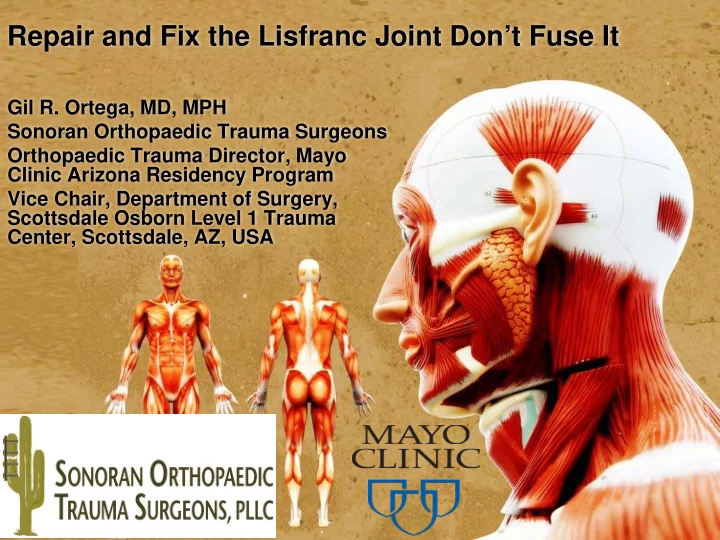

Repair and Fix the Lisfranc Joint Don’t Fuse It Gil R. Ortega, MD, MPH Sonoran Orthopaedic Trauma Surgeons Orthopaedic Trauma Director, Mayo Clinic Arizona Residency Program Vice Chair, Department of Surgery, Scottsdale Osborn Level 1 Trauma Center, Scottsdale, AZ, USA
Disclosures • Founding Member, Orthopaedic Board of Advisors: Carbofix • Founding Member, Orthopaedic Board of Advisors: Artross Nanobone • Consultant: Smith and Nephew
Why Fuse a joint that suffers a ligament injury without a fracture? • Do we fuse shoulder or elbow joints after dislocations without fractures? • Do we fuse hips after dislocations without fractures? • Do we fuse knees after knee dislocations with ligament injuries only? • Do we fuse ankles after ankle dislocations without fractures? • NO OF COURSE NOT…So why fuse the Lisfranc?
Fusing a Lisfranc joint after a dislocation makes no physiologic sense • A Lisfranc injury is a ligamentous injury with or without associated fractures
The Weak Argument to Fuse a Lisfranc is based on one study • Forty-one patients in prospective, randomized clinical trial comparing primary arthrodesis with ORIF • Patients followed for average of 42.5 months Evaluation was performed with clinical examination, radiography, American Orthopaedic Foot and Ankle Society (AOFAS) Midfoot Scale, a visual analog pain scale, and a clinical questionnaire
The Weak Argument to Fuse a Lisfranc is based on one study • Twenty patients-ORIF and 21-Fusion • Two years postop, mean AOFAS Midfoot score was 68.6 points in ORIF and 88 points in the arthrodesis group (p < 0.005) • Five patients in open-reduction group had persistent pain with development of deformity or osteoarthrosis, and they were eventually treated with arthrodesis
The Weak Argument to Fuse a Lisfranc is based on only one study • Patients who had been treated with fusion estimated that their postoperative level of activities was 92% of their preinjury level, whereas ORIF estimated postoperative level was only 65% of their preoperative level (p < 0.005) • Was study powered enough to make these practice guideline conclusions? Ly TV 1 , Coetzee JC. T reatment of primarily ligamentous Lisfranc joint injuries: primary • arthrodesis compared with open reduction and internal fixation. A prospective, randomized study. J Bone Joint Surg Am. 2006 Mar;88(3):514-20
The major issues with that one study • They did ORIF with transarticular screw fixation • Why would anyone use transarticular screws to fix a ligament injury? • Why would you “screw up” a joint surface? • Do we do that with any other joint injury? – NO!
Fusing a Lisfranc joint after a dislocation makes no physiologic sense • Fusion has several current limitations • NO long-term data exist regarding the function of patients fusion for Lisfranc injury • Perhaps, similar to ORIF, results of fusion may diminish with time • The ORIF comparison group underwent transarticular fixation which likely leads to degenerative changes seen postoperatively
The Weak Argument to Fuse a Lisfranc is based on only one study • All remaining studies have all found equivalent, but not superior, functional outcomes compared with modern series of ORIF • Fusion is not without complication. Rates of nonunion of up to 33% have been reported • Adjacent joint degenerative changes have been seen in 12% of patients
The Argument for Dorsal Plating for Fixation without Mucking up the Articular surfaces • Makes more physiological sense not to touch articular surfaces • Anatomic reduction obtained and maintained • Stern al showed 15 patients at one year follow-up with AOFAS Midfoot Scores with mean score was 85, with a range from 78 to 92 with maintenance of reductions • Stern et al. Dorsal Multiple Plating Without Routine Transarticular Screws for Fixation of Lisfranc Injury. Orthopedics. 2014; 37 (12): 815-819
My Personal Experience with Dorsal Plating as Compared to Transarticular Fixation or Fusion? • Of course the findings show better outcomes with Dorsal Plating and anatomic reduction
Thank You
Recommend
More recommend